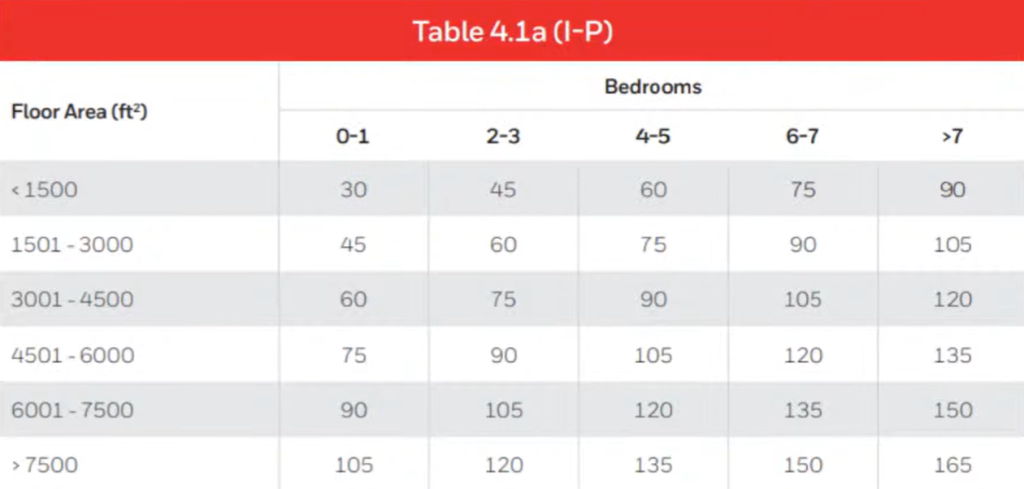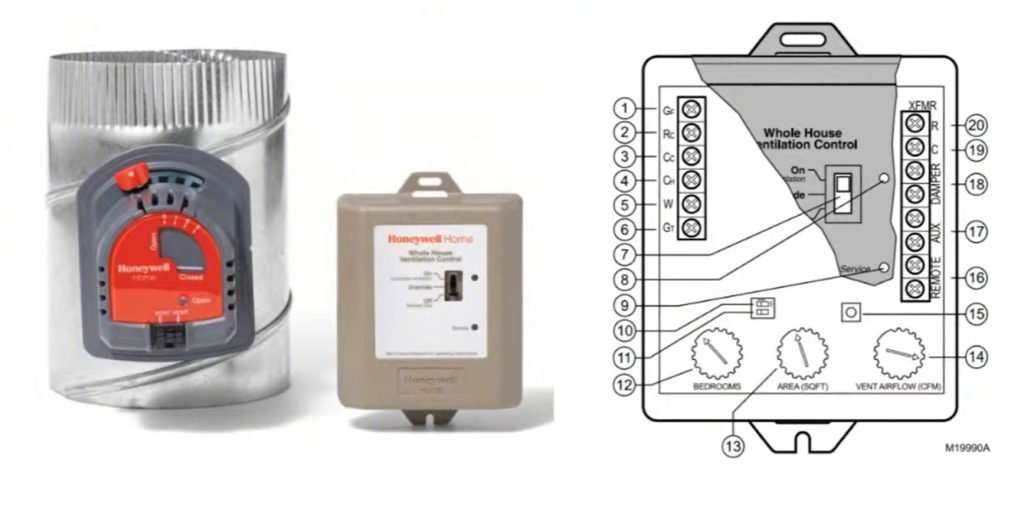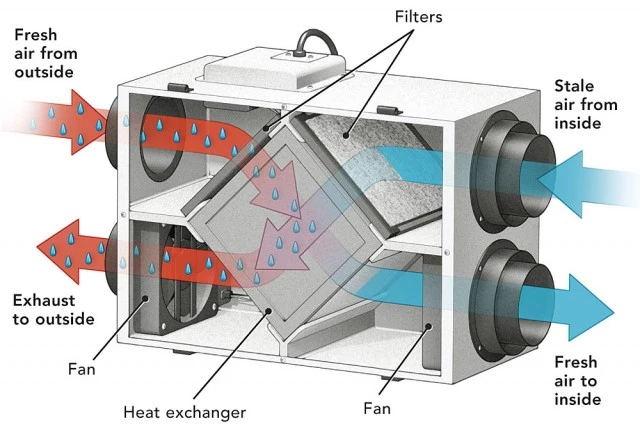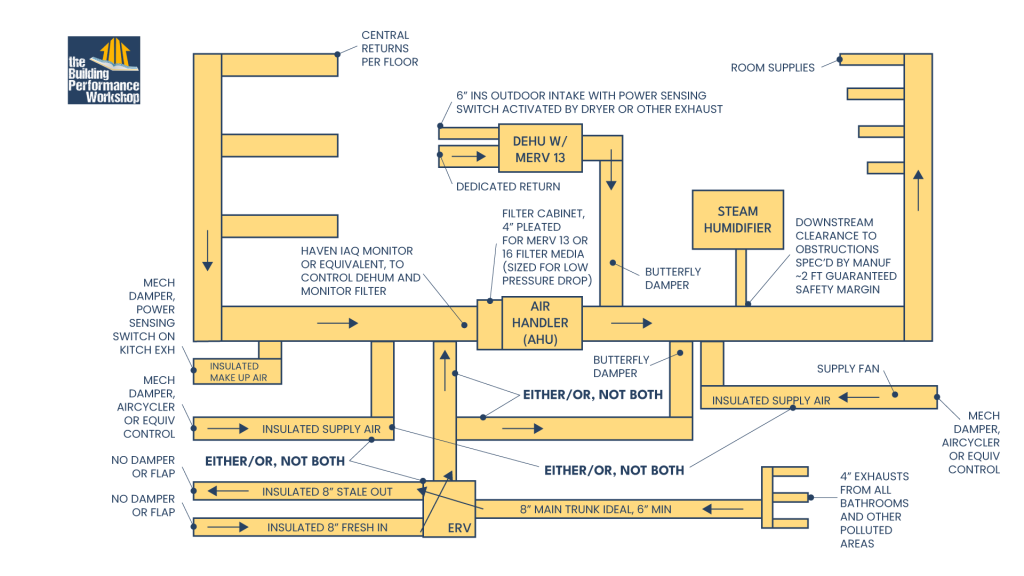Get Tech Tips
Subscribe to free tech tips.
Ventilation Strategies: ERVs, Dehumidifiers, and More

This tech tip recaps the livestream by the same name, featuring HVAC School contributors Matt Bruner and Adam Mufich, as well as special guests Corbett Lunsford and John Semmelhack. You can watch that livestream on our YouTube channel HERE, and you can learn more about the great educational opportunities Corbett has to offer at https://buildingperformanceworkshop.com/.
Ventilation is the V in HVAC, but it’s the one that we seem to talk about the least. And when we do talk about it, it’s often in very specific contexts, like ASHRAE Standard 62.2 (fresh-air ventilation standards in low-rise residential buildings).
However, there’s a lot more to ventilation than just bringing in outdoor air. Ventilation boils down to air movement, especially into and out of a space. Proper ventilation is a key element of indoor air quality, which directly affects occupant health and safety, and it can be affected by the ways we bring in and exhaust air, duct design, and the building envelope itself.
The 5 Factors of Ventilation
It helps to think of ventilation as a combination of five things that all affect each other:
Circulation
Ventilation is largely about air movement, and circulation describes the paths that the air takes. We can think of circulation in a few different ways.
Circulation may refer to how air mixes within a room. It also may refer to the way air moves between rooms. Some HVAC systems are better at achieving those than others; for example, mini-splits aren’t typically great at either without help from something like a ceiling fan.
Air moves between rooms due to pressure differences between those rooms. (Remember: as with temperature, air molecules will want to move from areas of higher pressure to lower pressure until they reach equilibrium.)
Capture & Filtration
As air moves through an HVAC system and is redistributed throughout the home, we want to remove things that are bad for our health, like cooking fumes, bathroom humidity and odors, and general dust, dander, skin flakes, and other particulate matter. Capture is basically spot exhaust in kitchens and bathrooms. Filtration allows us to remove those things from the air everywhere else, but we need to be careful about using a filter that has a high enough surface area to remove as many particles as possible without impeding the airflow.
Once you know how you’ll capture those contaminants, you need to circle back to circulation: how are you going to distribute and circulate that filtered air?
Humidity Control
We need to control our indoor environment to maintain a moderate humidity level (30-60%) to reduce the risk of bacterial or fungal growth, allergens, and VOCs indoors. Humidity control can happen at the indoor unit, such as when we get a cold coil with long runtimes in the Southeastern United States, or with supplementary equipment, like a dehumidifier.
Homes that are substantially airtight, and therefore have continuously running mechanical ventilation systems for dilution air (see below), will have VERY different dynamics of humidity control than typical older homes, and occupants may end up needing dehumidification in a ‘dry’ climate, or humidification in ‘humid’ climates in cold months.
But then we need to circle back: do we need to filter the air before we dehumidify it? Then, how are we going to distribute and circulate that dehumidified air?
Dilution Air
Now we’re getting into the part of ventilation that really relates to ASHRAE 62.2. Dilution air comes from outdoors and dilutes the presence of indoor contaminants, including CO2 and odors (some of which are associated with VOCs in paints, furniture, etc.). The chart below shows what the generic CFM requirements would be for some homes based on ASHRAE Standard 62.2.

Credit: ASHRAE Standard 62.2
But then we have to think about humidity control; how do we make sure the air we bring in is at an acceptable humidity level? Do we need to filter pollen and other outdoor contaminants out of incoming air? How will we tie that outdoor air into the duct system for circulation?
Pressure Relief
Some homes, especially airtight ones, also need pressure relief from one-way exhausts, like kitchen range hoods, since those homes may have airtightness blower door scores of under 400 CFM. Building codes currently state that a home only needs make-up air when it has an exhaust hood bigger than 400 CFM, which is why you don’t listen to code when it comes to this stuff; you listen to industry professionals.
Even once that has been figured out, you will need to think about how the pressure relief will affect the dilution air you bring in and how humidity control, filtration, and circulation will be affected.
Ventilation Strategies

Ventilation comes in a few different forms, and each one has a different effect on the building envelope.
Exhaust Only (Negative)
Exhaust-only ventilation happens when we exhaust air from the space without bringing any back in. It’s the least expensive ventilation strategy.
Utilizing exhaust-only ventilation is better than having no ventilation whatsoever, but you don’t have a lot of control over where the “fresh” air is coming from. That air will come in through cracks in the building’s envelope near the exhaust fan, and you could bring in very hot, humid attic air. Bath fans and range hoods running continuously or on timers are examples of exhaust-only ventilation.
Supply Only (Positive)
Supply-only ventilation happens when you bring air into a space through a duct. The air usually comes in with help from the air handler or furnace and negative pressure in the return (if the duct is tied into the return duct or plenum) or a dedicated powered fan (if tied into the supply).
As its name suggests, this strategy puts the house under positive pressure (probably not much though).
Balanced
A balanced ventilation strategy has an equal amount of exhaust air and intake air. We usually achieve balanced ventilation with a single machine with two separate motors, such as an energy recovery ventilator (ERV) or heat recovery ventilator (HRV).
ERVs exchange sensible and latent heat between the intake and exhaust air, and HRVs only exchange sensible heat between the two sources. In other words, ERVs buffer both temperature and humidity, whereas HRVs only buffer temperature. This short podcast explains a bit more about how HRVs and ERVs work.
Bringing in Outdoor Air Safely
We have a few different ways to bring in outdoor air, including HRVs and ERVs. However, bringing in safe dilution air isn’t as simple as installing an ERV and calling it good. We need to make sure that the incoming air meets the following criteria:
- Not heavy in outdoor pollutants (like pollen or particulate matter from wildfires and power plants)
- Adequate temperature for comfort
- Safe and comfortable humidity level
Fine particles also pose a problem, and the only way to remove them from the incoming air is via filtration. Recent wildfire events have forced the industry to rethink filtration for dilution air, with newer models requiring MERV 16 filters that remove ~95% of fine particles from the outdoor air (nearing HEPA levels).
Humidity management can be very tricky. Dehumidifiers work a lot like air conditioning units; humid air passes over a coil, which pulls moisture out of the air. That said, in some climates, it’s very difficult for ventilating dehumidifiers or ERVs to remove enough humidity from the incoming air, and the tighter building standards for new homes make dehumidification even more critical.
One of the downsides of ERVs is that they don’t stop regardless of the weather conditions. They’ll bring in “fresh” air even on cool, rainy days, which may especially spell trouble for occupants in the Southeastern United States. The outdoor air usually has a higher humidity level than the inside about 75% of the time, even despite taking showers and cooking indoors. Not to mention, the outdoor cooling design temperature and mean coincident dry bulb (MCDB) for the dehumidification design conditions may vary by as much as 20°F in some parts of the country.
Tying ERVs into Bath Fans
In some airtight homes, one-way bathroom exhaust isn’t a safe option. We will need to bring in some outdoor air to offset the pressure, and some people use ERVs to accomplish that. ERVs bring in outdoor air as the indoor air is being exhausted, so it keeps things balanced.
The top five ERV manufacturers have also given the bath exhaust tie-in design their seal of approval.
Basic Ventilation
One of the most basic ventilation kits you can install consists of a ventilation damper and controller that ties into the return. The controller communicates with the air handler and opens the damper based on runtimes, or it’ll send a fan call to the air handler and open the damper if the system is not running.

This basic kit relies on the negative return side duct pressure to move the air, not a powered fan. The downside of this configuration is that you must have sufficient return duct pressure to get airflow through the damper, and higher return static pressure is usually much more desirable. This might be difficult to accomplish if your “fan on” blower speed moves less CFM than the heating or cooling fan speeds. It’s the same principle that explains why we can’t use passive makeup air in homes with fireplaces; equalized pressures won’t allow airflow, and you can backdraft a fireplace.
How to Know What to Bring In
There are tools that you can use to determine how much air needs to come in or be exhausted. One of those is the free depressurization analysis calculator by RED Calc.
You can use this calculator to determine how much CFM of fresh air you will need to bring in to offset the building leakage if you know the exhaust flow and depressurization. (You can also solve for any one variable if you know the other two variables; you can figure out depressurization if you know the building leakage at 50 Pascals and exhaust flow.)
In general, the building volume matters, and you’ll want to start making these calculations when the building nears 1.5 air changes per hour (ACH).
It’s also not recommended to add fresh air to the structure without doing calculations or testing of any sort, including a blower door test. Even then, the next step after a blower test would ideally be to monitor the indoor air quality and determine if adding fresh air is indeed the best thing to do. The goal is to provide a solution tailored to each individual house’s needs.
ERV Considerations
ERV sizing will depend on fresh air standards and how much exhaust air you need to offset. You can figure out how many CFM of fresh air you need to bring in by comparing ASHRAE Standard 62.2 to your exhaust needs and determining which one is greater. Then, account for an extra 30–50% capacity so that there is some room to vary the performance depending on the conditions.
Some ERVs also have cloud-sensing capabilities. They monitor outdoor conditions and shut off if the outdoor air quality isn’t adequate, such as if the humidity is too high.

If the ERV dumps air into the return, then the air handler may need to run continuously at a low fan speed. The ERV will bring in some humidity only if the outside air has a moisture content than the inside air. This is because ERVs are not 100% efficient. The outside air will mix with the air in the return. If the system is running in cooling mode, the humidity from the ERV can be removed by passing over a cold evaporator coil. Otherwise, when the call for cooling is satisfied, the ERV may be designed to bypass the central duct system entirely and dump air into the space through a return grille. However, that brings a high risk of condensation in humid climates.
Dedicated Duct Systems for ERVs
While the installation of a dedicated duct system for an ERV has a pretty big impact on system efficacy, the theory behind it is pretty important.
There are cases when the air in a home can’t circulate as intended, such as when people sleep in the bedroom with their door closed or work from home and close the door for a meeting. The best way to ensure that you have the best comfort and ventilation control is to have an independent distribution system for the ERV that supplies ventilation air to each room.
When you tie an ERV supply directly into the HVAC supply instead, you may have to make a choice to balance the airflow based on comfort or IAQ. You have a lot less control than you’d have with dedicated ductwork for the ERV.
The downside of installing an ERV with a dedicated duct system is an increase in the cost of installation. This is especially true in retrofit applications.
Exhaust Only Ventilation
Exhaust-only ventilation is usually better than none at all, but it comes with a unique set of risks.
If the structure is under a lot of negative pressure, then it’s possible that additional exhaust ventilation could create conditions that resemble that of a blower door test. Gas-fired appliances, including fireplaces, may backdraft as a result. Things like makeup air (MUA) systems can help bring in fresh air to replace exhaust air, especially in kitchens with gas-fired appliances. Kitchens are often the largest source of harmful indoor pollutants, so the need for ventilation is usually critical.

Exhaust paths also need to go one way out of the home. Recirculating things like natural gas pollutants or combustion products from a range can negatively impact the occupants’ health.
Tying Fresh Air Ducts Directly into the Return
Simply stated, tying fresh air ducts directly into the return requires special considerations at best and is a recipe for disaster at worst.
It’s not a good idea at all in Climate Zone 1 (think Miami, FL) due to the very high temperature and humidity.
In other climates, especially the Midwestern United States, exceptionally humid shoulder seasons and cold winters pose a unique challenge. The moist outside air will come into contact with the cool surface of the duct and reach the dew point, which causes condensation on the ducts. Condensation on the inside or outside of the duct can lead to indoor air quality issues, and it can happen on ducts of any material.
Other Things to Consider
The number-one thing to consider about ventilation strategies is that there is not a one-size-fits-all solution. There are specific climate and lifestyle factors that will affect the need for ventilation.

Credit: Corbett Lunsford (The Building Performance Workshop)
One of those is, as mentioned earlier, the need for more advanced filtration—at least MERV 16—when the outdoor air is laden with pollutants, such as during wildfires. Those situations are not always predictable, but systems designed with the capability to mitigate those risks will bring in higher-quality air.
The same applies to when we need to go into “airborne virus mode,” which is when the ventilation system may need to ramp up the air changes per hour (or “air cleanings per hour”) to dilute and filter out viral pollutants in the air when there are more occupants present. For that reason, it’s usually advantageous to have a little bit of variability in the ventilation strategy. (And some ERVs may not have much variability, so be sure to know the equipment you’re installing.) MERV 16 or better filtration is also important for removing contaminants from the airstream.
However, that brings us to the conversation of simple vs. complex. The verdict is that it really depends on the customer. Some contractors know that they will need to install as simple of a system as possible—like an outdoor duct with a damper instead of a full-blown ERV—because customers may not be willing to maintain units like ERVs. You will need to discuss the maintenance needs with your client to see where they stand. That conversation will help you determine if a simple or more complex solution will be better for their specific needs.
Design-Specific Considerations
When we’re thinking about ventilation in a structure, we’ll need to consider the use of space to install the equipment properly. Is there room for an ERV? Will we get a relatively straight run of ductwork? If you were to put in a ventilating dehumidifier, how would you route that drain? Can you run it in such a way that it drains out to a safe location while following local codes?
Many of these design-specific considerations will be easier to address in new constructions. They can be quite a challenge if you want to apply a ventilation strategy to an existing home that wasn’t designed with ventilation equipment in mind.
In some existing homes, it may be easiest to approach the need for ventilation by running the bath fans and assessing the needs from there.
Air circulation is also an important design factor, especially in high-performance homes (especially those with mini-splits and in cases where the air handler or furnace doesn’t run at night). Bedrooms with closed doors will have naturally high CO2 levels in cases where the HVAC doesn’t run and circulate the air, which isn’t ideal for occupant health.
You can also identify the problem you aim to solve using the “four Ps” of building science; you have an IAQ problem when you have people, pollutants, pathways, and pressure. The interesting part about the four Ps is that you can solve most problems by taking away just one of those “P” components. (Neil Comparetto wrote a great tech tip about these four Ps HERE.)
Corbett approaches ventilation system design with the 4-3-2-1 method: four elements, three improvements, two systems, and one goal.
Taking Credit for Infiltration
Infiltration, or air that enters a space uncontrolled, is another aspect of ventilation that we ought to think about. We should be aware of infiltration and monitor it (to the best of our abilities) before making decisions to address it.
That said, we can take credit for it in single-family homes. (ASHRAE Standard 62.2 allows you to do so if you perform a blower door test. You can’t take credit for infiltration by doing a blower door test in multi-family homes.) But just because we can doesn’t necessarily mean it’s the best decision. Moreover, the credit may not amount to very much if there’s already an operable ventilation system in use.
Conclusion
There is no perfect ventilation strategy for every situation, though some degree of modulation and flexibility will always be advantageous, regardless of the device you use to bring in or exhaust air (bath fans, ERVs, etc.).
Ventilation also heavily depends on air pressures when we’re not relying on powered fans to move the air. We ought to be especially careful of home pressures when it comes to installing exhaust ventilation and combustion appliances, which may backdraft under the right conditions.
No other industry is required to understand air pressure and flow quite like HVAC, and there are quite a few comfort, health, and safety considerations that come with manipulating air pressure and flow. Knowing the various ventilation strategies will give you a leg-up when it comes to mitigating comfort, health, and safety issues for the benefit of your clients.
P.S. — This tech tip and livestream are very residential-heavy, but we have some external resources if you’re interested in the commercial side. If you’d like to learn more about ERVs and dedicated outdoor air systems (DOAS) in high-performance commercial buildings, you may want to check out the free Optimized Ventilation for High-Performance Buildings webinar on the HVACR Learning Network. There are also several paid courses that dive into the ASHRAE ventilation and IAQ standards, including a course package all about Standard 62.1.











Comments
To leave a comment, you need to log in.
Log In